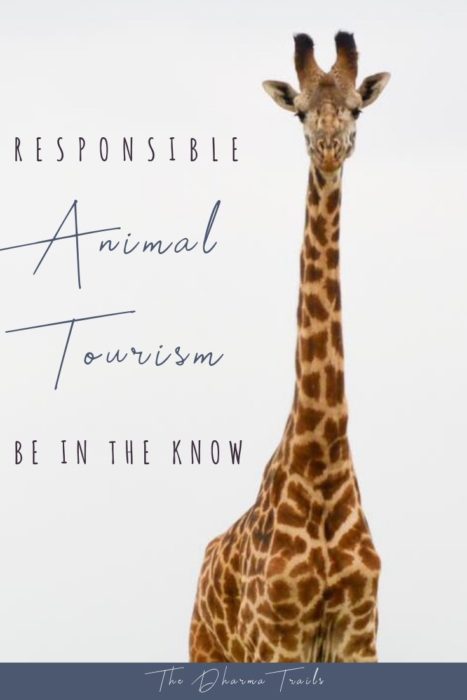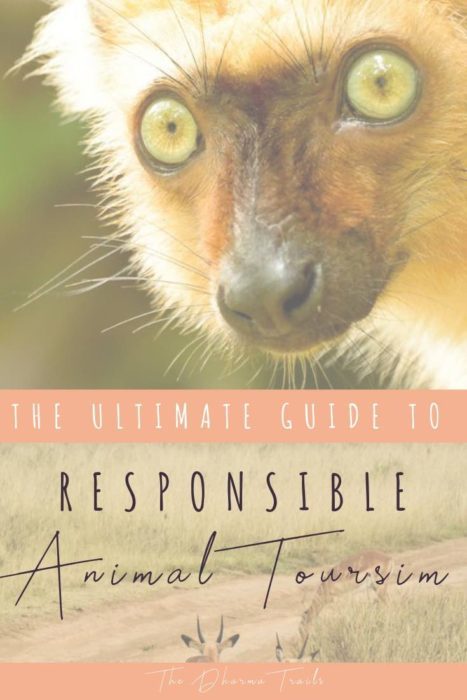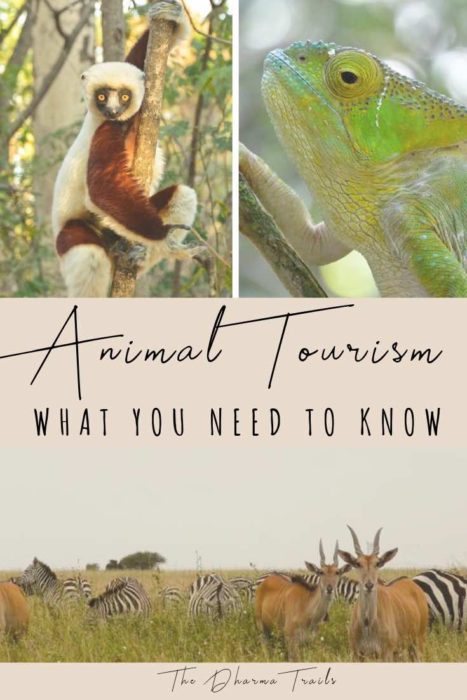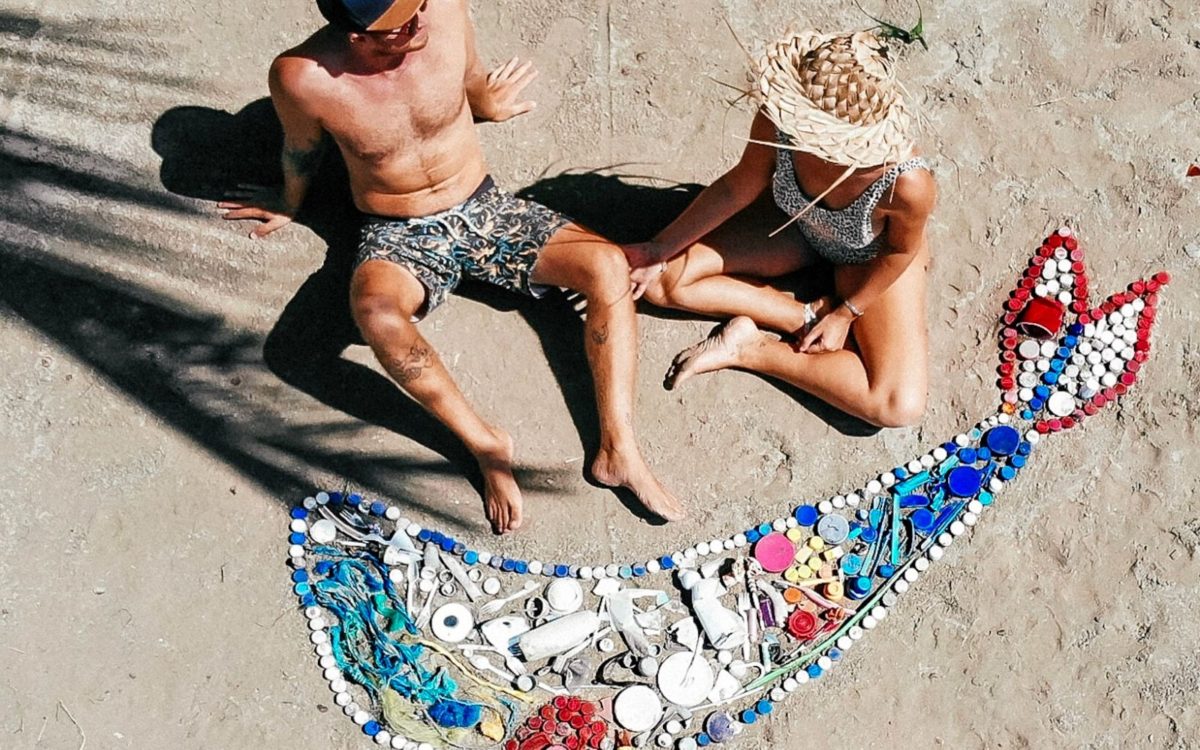This is a controversial topic no matter where you start. But as eco travel becomes more popular, we all need to be aware of animal tourism. People do things like riding elephants, picking animals up for a photo when it just wants to ‘be’. Is this really what animal tourism is?
This post may contain affiliate links, which means I may earn a commission if you click a link and make a purchase. As an Amazon Associate, I earn from qualifying purchases.
The only hopeful reason for this kind of behavior is that people are misinformed about ethical animal interactions. We need to be aware of animal tourism and it’s real effects.
Table of Contents
Wild animal tourism numbers

Our ability as humans to impact the planet is astounding. A recent report by the World Wildlife Foundation (WWF), denotes that the total animal population (mammals, birds, fish, reptiles, and amphibians) has declined by 60% since 1970, with deforestation playing a big role.
Many animals end up in sanctuaries or conservation parks around the world because of this reason. As the animal population declines, their popularity as tourist attractions increases.
Approximately 110 million people visit wildlife tourist attractions around the globe each year
World Animal Protection
The mistreatment of the animals themselves is the main concern for animal tourism. Unfortunately, it happens more than we’d like to believe. The World Animal Protection has released the following statistics:
- 75% Of wildlife tourist attractions have a negative impact on wild animals
- 80% Of tourists cannot see the negative impact a Wildlife Tourists Attraction has on animal welfare.
- 16,000 is the number of elephants in captivity worldwide – a quarter of the total number on the planet.
- 5,000 is the number of captive tigers in the US alone. In the wild, there are just 3,200.
- 1,600 is the estimated number of bottlenose dolphins being used for entertainment worldwide.
- 4 Million Number of visitors to SeaWorld San Diego in 2012.
A brief history of Animal Tourism
The monetization of animal tourism goes back as far as the Roman Empire (at least).
“Capturing and transporting live animals from distant lands was a lucrative industry in the Roman provinces. And, most of them were killed in live hunting shows, or animal battles.”
– The Atlantic
This has been documented as far back as Augustus (the first Roman emperor), where he claims that “he had 3,500 African animals killed in 26 venationes (death battles) over the course of his reign.”
It didn’t end there; “the emperor Titus inaugurated the Colosseum with a hundred days of spectacle in which 5,000 wild beasts were killed. And in public games held from 108 to 109 C.E., the emperor Trajan arranged for 11,000 animals to fight in the arena.”
This was animal tourism of the Roman era.

Killing to Tricks
The Romans noticed intelligence in elephants.
“Pompey’s elephant-hunt spectacle, which took place close to the end of the Roman Republic, provoked an emotional response from the crowds. When the elephants had lost all hope of escape, they tried to gain the compassion of the crowd by indescribable gestures of entreaty, deploring their fate with a sort of wailing”
– The Atlantic
In between their brutal battles, elephants were shackled and forced to perform tasks. Pliny (a Roman author, naturalist, and natural philosopher), in his Natural History, suggests that elephants would be found practicing these tasks on their own accord.
Animals became more than blood battles, they had the ability to perform assigned tasks.
“There were no zoos in ancient Rome but there was something like a cross between a zoo and a circus. All these species were used for shows in the arena; some were also kept by the wealthy for their own entertainment. We know from writings, for example, that monkeys would be dressed as soldiers and ride in small chariots pulled by goats.”
– Explore Italian Culture

When tricks hit the road
The Romans had grand stages and arenas for their wild animals to be paraded. But once the empire declined, the owners of these remaining trained animals, had to find other ways to make a profit.
“Lacking great stadiums in which to present them, caravans of trained animals would often travel to the people.” And so began the concept of the traveling animal show.
“These circuses, as they would come to be known, soon sprang up throughout Europe and, by the 1790s, in the New World as well. Often they were not elaborate affairs. In about the year 1815, an early pioneer in the industry, New York native Hackaliah Bailey, traveled throughout New England with a single elephant he purchased from a boat captain who had won it in an auction in London. His success spurred many imitators, and soon exotic animals from throughout the world were imported and exploited for profit.”
– The Dodo

The exotic tourist hunt
“The Safari intrigue peaked when former U.S. President Theodore Roosevelt went to East Africa to hunt big game from April 1909 to March 1910. The specimens collected were for the ‘National Museum’, which is now called the Smithsonian Institution’s Museum of Natural History.”
– Where is the Wildlife
Thankfully now you can go on a “safari” without having to kill any of the animals. Unfortunately, some people still use the exercise to sport-hunt some near-endangered species.

The dolphin show
Skip ahead a few years and iterations of the zoo to Florida, USA, in 1938. This saw the opening of ‘Marine Studios’ and the introduction of the bottlenose dolphin for public display.
Investigative journalist, William M. Johnson writes in his book The Rose-Tinted Menagerie, dolphins potential as entertainers first emerged when:
“During feeding time at Marine Studios, it is said, dolphins gradually fell into the habit of jumping up to catch the fish that were thrown to them, and this miniature spectacle always amused the public, the keepers and curator. Then a year later in 1939, Cecil M. Walker on the night-shift observed one evening how a dolphin pushed a pelican feather across the surface of the water towards him. Just for the hell of it he took the feather and threw it back into the water, whereupon, to his great surprise, the dolphin brought it back again. The game continued with Walker experimenting with a ball, an inner tube of a bicycle, small stones, and other objects. As the game took shape with other dolphins joining in the act, it began to resemble the repertoire seen today in every dolphinarium in the world.”
The Rose Tinted Menagerie
With the explosion of dolphinariums over the years came the exploitation of so many species.
Types of animal tourism and their effect
The main platforms for animal tourism include:
- Zoos
- Aquariums
- Sanctuaries
- Wild Interaction
- Circus
- Shows
- Fights
- Sale of exotic animals
- Photos with exotic animals

The real animal tourism effects you don’t see
How do the animals get into their captive lives? And what is it like for them once inside?
A report by World Animal Protection summarises the most popular animal tourism attractions around the world with their direct, negative impacts.
| Animal Attraction | The actual effect on animal |
|---|---|
| Riding Elephants | Taken from mothers when babies Subjected to pain to control their behavior Prevented from developing social interactions leading to psychological trauma Kept in small cages |
| Taking Tiger Selfies | Taken from mothers when babies Sold on the black market |
| Walking with Lions | Taken from mothers when babies Face a lifetime of captivity |
| Bear Parks | Bears kept in sterile ‘pits’ Forced to be in groups leads to fighting, injury, and psychological trauma |
| Holding Sea Turtles | Holding causes stress, which can weaken the immune system 1,300 turtles died in the Cayman Turtle (Holding) Farm due to an outbreak of disease |
| Performing Dolphins | Chased by high-speed powerboats with nets Taken from family Many die from the stress before they get to the enclosure Then live out their lives in small pools |
| Dancing Monkeys | Trained aggressively and painfully, to make them walk, behave and appear more human Often kept chained in small barren cages or outside on short chains. As the macaque grows, the chain can become embedded in the skin leading to painful infections and disease |
| Civets in Coffee Plantations | Caged civets are encouraged to gorge on an unbalanced diet of coffee cherries. This unnatural captivity and forced feeding results in injuries, disease, and poor nutrition. Many show signs of great stress |
| Holding/ Kissing cobras | Cobras are usually captured from the wild, then they are defanged with metal pliers and their venom ducts are either blocked or removed This often results in painful infections and can kill the cobras |
| Crocodile Farms | Kept on farms and intensively bred — usually for their meat or to supply the fashion industry Usually housed in overcrowded and unhygienic concrete pits The crocodiles will fight each other, sometimes to the death. |
What about eco-tourism animal attractions?

A current, popular “eco-tourism” attraction is causing quite a bit of controversy. It is swimming with Whale Sharks, in Oslob (Philippines).
Every day, boatloads of tourists go to a location where local fishermen “feed” the whale sharks (by hand, which means that the Sharks breach the surface) while tourists swim around them and get photographs. Is this what it means to eco travel?
An upside to it all?
“The scene at Oslob is chaotic, and the controversy is real,” “But the sharks are alive and not lying dead, fins removed, in cold storage somewhere in Asia.”
National Geographic
The area is profiting, with “sixty percent of the tourism revenue going to the fishermen, thirty percent to the municipality and 10 percent to the local village” which helps the community.
It has also eased pressure on the depleted coral reefs as fewer fishermen are fishing on them.
A down side?
There’s always two sides to every story.
Some of the sharks are becoming dependant on the food supply. “Scientists worry that sharks that take advantage of the free feed for prolonged periods may suffer ill effects, both physiologically and behaviorally.“
The system is also far from perfect. “A survey by LAMAVE, found that rules and guidelines regarding responsible whale shark sighting were being broken a whopping 97% of the time. In most cases, it was the physical touching of the Whale Sharks.”
Can animal tourism have a truly positive effect?
The Great Ape tourism industry has a long standing history:
- As one of the leaders of animal tourism, there are strict guidelines for best practices.
- The industry has been at the forefront of animal activism and education into the world of non-human group interaction.
- It is thought to be non-invasive (no physical touching of the animals themselves, taking only small groups going at a time).
The intentions of Gorilla tourism are great. The main objective is to contribute to gorilla conservation – through raising awareness, assuring protected habitat, and bringing in revenue.
However, it isn’t one-sided. For example, the benefits vs. risks of the gorilla tourism industry cover many grey areas. It really depends on who you ask if it’s a “good” or “bad” thing.
The Table below (from UNAFAS (9)) highlights some of the pro’s and con’s of the industry on conservation and the community.


What about coral?
Coral is actually an animal (not a marine plant) because they do not make their own food, as plants do. Corals have tiny, tentacle-like arms that they use to capture their food from the water and sweep into their inscrutable mouths.
Many locations around the world (scientific labs, marine conversation parks, private aquariums) take coral from the wild and encourage its growth or house them in tanks for public viewing. This is a kind of zoo.
Is that just as bad as keeping lions in a zoo?
Marine parks on the other hand are more like conservation parks. Our favorite is St John in the USVI.
Alternatively, if we don’t study them or try to save them, we may result in even more natural loss. It poses the question, should corals be taken from their “home” when they are young and tampered with to try and learn how to save them? Or even be bred for mass reproduction in order to increase the natural population that’s been dying due to human interference?
This is where ethics really comes into play.

Ethics in Animal tourism
Ethics in animal tourism breaks down into two main concerns:
- Animal rights
- Animal welfare
The best example of the ethical battle on animal tourism is given by the BBC in the following example of Zoos vs. Circuses.
Animals in zoos
Animal rights:
If animals have rights, then zoos are wrong because it:
- treats the animal as a means to achieve some human end
- fails to treat animals with the respect they deserve
- violates the animal’s right to live in freedom
Animal welfare:
From the welfare point of view, it is wrong to keep an animal in a zoo if the animal has a less pleasant life than it would have outside the zoo.
Animals in circuses
Animal rights:
The use of animals to entertain human beings is wrong because it:
- treats the animal as a means to achieve some human end
- fails to treat animals with the respect they deserve
- violates the animal’s right to live in freedom
Animal welfare:
The use of animals to entertain human beings is wrong from the welfare point of view because it:
- removes animals from their natural habitat and social structure
- involves the animal in performances that are foreign to their natural behaviour
- may involve cruelty during the show (e.g. bullfighting, rodeos)
- may involve cruelty in training the animal
- it may involve cruelty in the way the animal is kept and transported
- animals can be taught to perform provided their minimum needs for food and shelter are met; proper respect for animals requires better treatment than the minimum
Animals Sanctuaries and Conservation Parks

Sanctuaries and conservation parks are the best option for animals in captivity. However, they are still in captivity (not by choice).
From an ethical standpoint:
- In order for the animal to arrive at a true sanctuary, it means that it has already undergone significant human interference and likely trauma.
- While their remaining life in a sanctuary may be improved, there will still be human interaction
- It’s also not viable to release the animals back into the wild most of the time. So the animals are essentially stuck in captivity.
For example, “while all elephants deserve to live in the wild, that is no longer a viable solution. Calls to ban all captive elephants in places like Thailand don’t take into account the reality that there is no longer enough land — nor adequate protection from poachers — to safely reintroduce wild elephants into most of Southeast Asia.”
Volunteering at a sanctuary in Bolivia, it was difficult to see, the animals, knowing they would likely never have a “normal life”.
So is it better to have animals living in an artificial reality (one depicted by humans) than not living at all?
Do animals have rights?
I think we’re all quite comfortable with the concept of animal wellbeing. But what about rights?
A great example of this is the “monkey selfie”. Famously orchestrated by the Naruto, a crested macaque monkey in Indonesia

In summary, a monkey took a photographer’s camera and shot a selfie of himself. The photo went viral and the photographer made some serious income from it.
This posed some ethical questions about animals’ ability to have ownership of something. PETA asked some serious questions, such as “doesn’t that photo belong to the monkey? Doesn’t he deserve some of those profits?”
After a series of lawsuits, it was deemed that the monkey had no rights. Luckily, the photographer was understanding and “donated 25% of his profits to protecting the monkey and his tribe.”
But should the monkey have gotten more?
The future of animal rights?
“Scientific research is contributing to a greater understanding of wild animals and reinforcing moral arguments against captivity. Studies have demonstrated that elephants, dolphins, and great apes are self-aware; the cognitive abilities of corvids and parrots rival great apes in many psychological areas, and octopuses possess neurological substrates known to generate consciousness.”
Birds have primate-like numbers of neurons in the forebrain & The Cambridge Declaration on Consciousness
“Psychologists propose that some nonhuman animals experience psychological trauma and mental health issues similar to humans, such as post-traumatic stress disorder.”
At this stage it’s up to us, the people, to decide how we want animals to be treated. I relate to this famous quote by Mahatma Gandhi. What do you think?
“The greatness of a nation and its moral progress can be judged by the way its animals are treated.”
Mahatma Gandhi
There is hope for Animal Tourism
Things are definitely changing for the better.
“TripAdvisor announced in October 2016 that it would remove from its website all opportunities for travelers to directly book animal tourism experiences through its platform. And in November 2015, SeaWorld responded to consumer protests and announced it would phase out its controversial killer whale show.
In another win for animal welfare advocates, elephants at the Ringling Bros. and Barnum & Bailey Circus performed their last show in May 2016 — all of the circus’ elephants have now retired to a 50-acre conservation center in Florida.
Choose ethical wildlife encounters
There are a lot of grey areas when it comes to the subject of animal tourism. The best wildlife experiences occur when you see them in their natural habitat, and you look, don’t touch. Alternatively, animal sanctuaries that follow the GFAS guidelines are the kinds of facilities we should be supporting. As an eco traveler, you should be not only aware but make conscious decisions about choosing which kind of animal tourism to support.
In contrast, animal shows, photo opportunities, zoos, or rides are definitely not.
If you’ve got any thoughts or experiences with animal tourism you’d like to share, let us know below.
Like This Article? Pin it!








A thought-provoking article, thankyou. But I found your conclusions to support sanctuary and conservation parks are only relevant to some parts of the world, and overlooks the very best option – the many excellent animal experiences in the wild. Could I suggest that you propose a scale of best to worst animal experiences. 1. See the animal in the wild at a distance where it is not fed, attracted or harassed in any way, with a tour operator or organisation that is active in conservation (eg Seeing koalas with Echidna Walkabout or Exceptional Kangaroo Island, Australia ). 2. See the animal in the wild where it is attracted by non-harmful means, and couldn’t be reliably seen any other way (eg . Pelagic birdwatching for albatrosses) 3. See the animal at a distance in a large, natural sanctuary that contributes to conservation (eg. Khama Rhino Sanctuary, Botswana), ….and so on.
Hi Jannie, thanks for your comment. Apologies for the delayed response, your comment seemed to go direct to our spam folder! So only just reading it now. Great idea! And yes, I think a rating scale would be very useful! Will check out the Echinda Walkabout Tour also 🙂